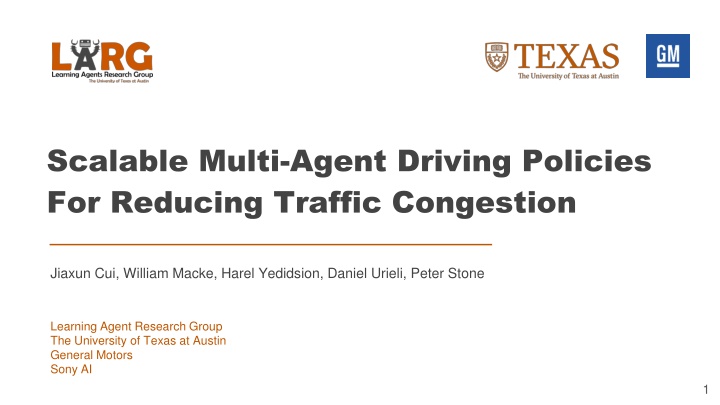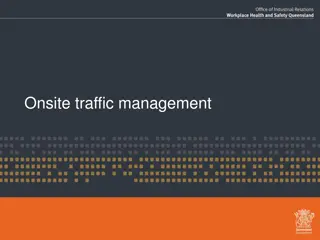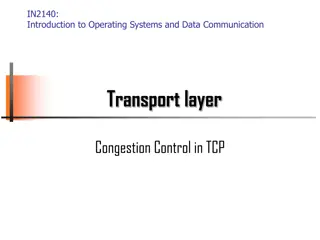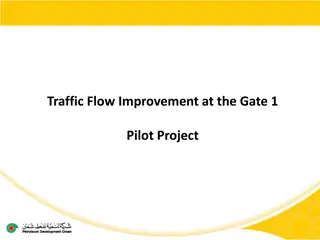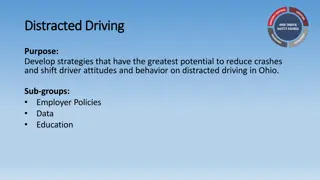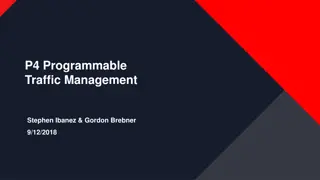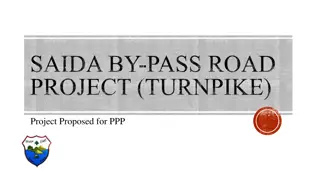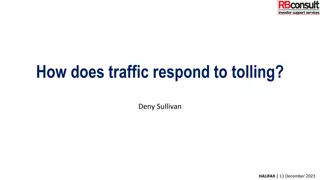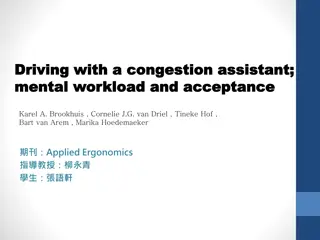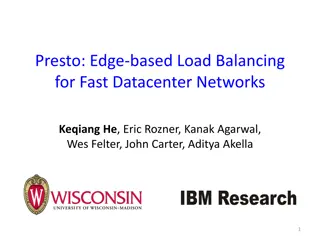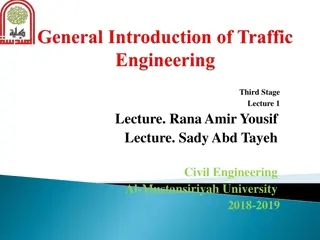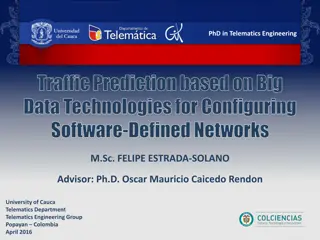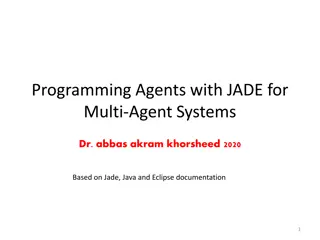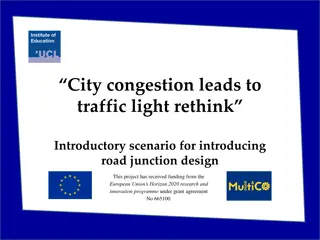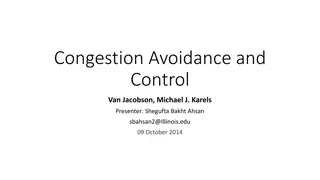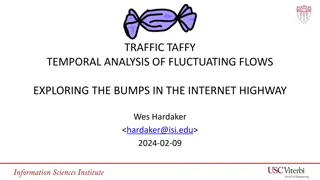Scalable Multi-Agent Driving Policies for Reducing Traffic Congestion
This research explores scalable multi-agent driving policies to reduce traffic congestion in large-scale open road networks by developing autonomous vehicle policies. The study delves into challenges such as large numbers of vehicles, policy search space increase, and credit assignment difficulties. Solutions involve centralized, modular, and decentralized policies, focusing on training, execution, and hierarchical learning. Metrics like average speed and time delay are key performance indicators in optimizing traffic flow.
Download Presentation

Please find below an Image/Link to download the presentation.
The content on the website is provided AS IS for your information and personal use only. It may not be sold, licensed, or shared on other websites without obtaining consent from the author.If you encounter any issues during the download, it is possible that the publisher has removed the file from their server.
You are allowed to download the files provided on this website for personal or commercial use, subject to the condition that they are used lawfully. All files are the property of their respective owners.
The content on the website is provided AS IS for your information and personal use only. It may not be sold, licensed, or shared on other websites without obtaining consent from the author.
E N D
Presentation Transcript
Scalable Multi-Agent Driving Policies For Reducing Traffic Congestion Jiaxun Cui, William Macke, Harel Yedidsion, Daniel Urieli, Peter Stone Learning Agent Research Group The University of Texas at Austin General Motors Sony AI 1
MITC-Previous work.mp4 E. Vinitsky, A. Kreidieh, L. Le Flem, N. Kheterpal, K. Jang, C. Wu, F. Wu, R. Liaw, E. Liang, and A. M. Bayen. Benchmarks for reinforcement learning in mixed-autonomy traffic. In Conference on Robot Learning, pages 399 409, 2018. 3
The goal is to scale to large networks I-696 Simple Merge 4
Problem Setting Develop a multiagent driving policy for Autonomous Vehicles (AV) in a mixed autonomy setting, in large-scale, open road networks, to mitigate traffic congestion Assumptions - Human driver behavior is homogeneous (IDM) with randomness IDM: Integrated Dynamic-Controller Module - Uniform Inflows - 10% AVs and 90% Human-Driven vehicles - Uniform AV distribution 5
Challenges for Open and Large Network Large number of vehicles in the network (~10X) Policy search space increases Credit assignment becomes harder. Any individual action has a much smaller effect on the entire system More delayed and noisier reward Larger variance in number of AVs in the network When monitoring a fixed number of AV, it becomes harder to determine the right number of AVs to monitor Long Simulation time 6
Our Solutions In this paper Centralized Policy Modular Policy Decentralized Policy Ongoing and future work Centralized Training Decentralized Execution Hierarchical Learning 7
Metrics Choosing the right objective function In open networks, improving the Average Speed metric can be achieved by reducing the number of vehicles in the system Average Speed - Inflows - vehicles/hour entering the system Outflows - vehicles/hour exiting the system Time Delay - (not supported in SUMO) 8
Environment Setting Main highway Inflow: 2000 vehs/hr, 10% Autonomous Vehicles, 90% Human Vehicles Merging Inflow: 200 vehs/hr, 100% Human Vehicles Episode Length: 1000 seconds, 2 steps/ second Reinforcement Learning Algorithm: Proximal Policy Optimization (PPO)[2] Main Highway Inflow: 2000 vehs/hr Merging Inflow: 200 vehs/hr [2] Schulman, J., Wolski, F., Dhariwal, P., Radford, A. and Klimov, O., 2017. Proximal policy optimization algorithms. arXiv preprint arXiv:1707.06347. 11
Centralized PPO Policy AVs [1] E. Vinitsky, A. Kreidieh, L. Le Flem, N. Kheterpal, K. Jang, C. Wu, F. Wu, R. Liaw, E. Liang, and A. M. Bayen. Benchmarks for reinforcement learning in mixed-autonomy traffic. In Conference on Robot Learning, pages 399 409, 2018. 13
Reward Design Flow Reward [1] (target speed Vd = 20 m/s) Average Speed Reward Outflow Reward [1] E. Vinitsky, A. Kreidieh, L. Le Flem, N. Kheterpal, K. Jang, C. Wu, F. Wu, R. Liaw, E. Liang, and A. M. Bayen. Benchmarks for reinforcement learning in mixed-autonomy traffic. In Conference on Robot Learning, pages 399 409, 2018. 14
Experiment Result Simple Merge Average Speed is Manipulable! The results are obtained from 100 independent evaluations with controlled randomness. We report the mean values of metric readings accompanied with their 95% confidence interval bounds. 15
Simple Merge Human 16
Simple Merge Outflow 17
Experiment Result I-696 Merge I-696 Merge is an Open and Large Merging Network With a fixed inflow rate and number of controllable autonomous vehicles. Simply training RL agents from scratch can not yield better-than- human results 21
Experiment Result I-696 Merge Training a policy a window near junction works much better than training for the entire road network from scratch 22
Experiment Result I-696 Merge Transferring a policy trained in the small network can provide a warm start and potentially saves time, as the bottleneck of training large network is simulation time Provides a direction for generalizing to new scenarios 23
Issues with Centralized Controllers Centralized Agent Does not handle dynamic number of agents Combinatorially enlarged search space Unrealistic in real settings due to safety concern 25
Decentralized Problem Setting Decentralized Agent RL Agent Each agent has its own policy based on local state information We use parameter sharing to cut down on state space RL RL RL Agent Agent Agent 26
New State Features We augment the local state space with additional features Distance to merge point Congestion ahead of vehicle Distance and speed of merging vehicle Junction 27
New State Features We augment the local state space with additional features Distance to merge point Congestion ahead of vehicle before merging Distance and speed of merging vehicle Junction Average speed of vehicles between junction and ego vehicle 28
New State Features We augment the local state space with additional features Distance to merge point Congestion ahead of vehicle before merging Distance and speed of merging vehicle Junction Speed and Distance of the first merging vehicle 29
New State Features We augment the local state space with additional features Distance to merge point Congestion ahead of vehicle before merging Distance and speed of merging vehicle Can be accessed through GPS and Vehicle-to-Vehicle Communication! Junction V2V communication Speed and Distance of the first merging vehicle 30
Reward Its a balance between to take or to give For each individual autonomous vehicle Selfish: to go through the junction as quickly as possible Cooperative: to have as many vehicles passing through the junction as possible Agents need to strike a balance between the two goals so that they can create a systematically smooth traffic flow, which benefits both themselves and others 32
Global vs Selfish Reward Mixing selfish and team rewards has been shown to improve convergence (1- )*R1+ *Re AV1 1- R1 Re AVn Rn 1- Ishan Durugkar, Elad Liebman, and Peter Stone. Balancing Individual Preferences and Shared Objectives in Multiagent Reinforcement Learning. In Proceedings of the 29th International Joint Conference on Artificial Intelligence (IJCAI 2020), July 2020. 33
Reward Function Cooperative Reward: Average Velocity Selfish Reward: Time Penalty (-1 every time step) and positive bonus for successfully exiting the network Final Reward: 1*Selfish_reward + 2* Cooperative_reward + bonus AVs are able to learn under this new function 34
Ablation Study State Space Fully decentralized policy with full augmentations can achieve similar episodic outflow as the best centralized policy with less training iterations centralized 35
Ablation Study Reward Mixing Cooperative reward alone does not encourage agents to exit the simulation network, they get stuck in the network to gain more rewards 36
Video: Collaborative reward does not encourage the vehicles to leave the network 37
Ablation Study Reward Mixing It achieves best result outflow when trained with mostly selfish reward and a small portion of global reward 38
Ablation Study Reward Mixing Selfish reward alone can work good enough in improving the traffic efficiency, though slightly worse than the mixed 40
Future Work Expand to additional and more complicated road structures (i.e. multiple lanes, different merge points, multiple merge points) Create general policies that can handle multiple road structures Attempt to transfer learned policies to actual AVs 41
Summary Open Networks provide additional challenges, such as exploiting inflows RL can improve efficiency on larger road networks We show a fully distributed policy that improves congestion 42
Scalable Multi-Agent Driving Policies For Reducing Traffic Congestion Jiaxun Cui, William Macke, Harel Yedidsion, Daniel Urieli, Peter Stone Learning Agent Research Group The University of Texas at Austin General Motors Sony AI 43
